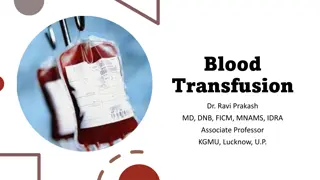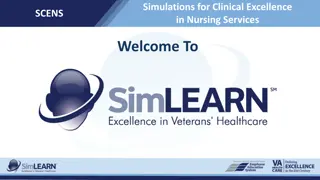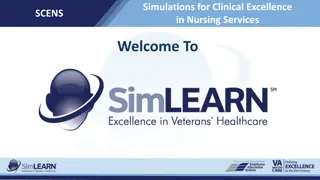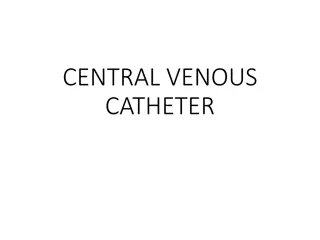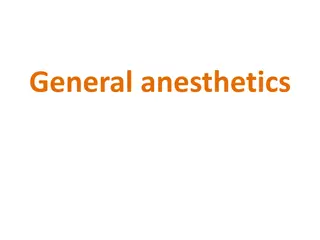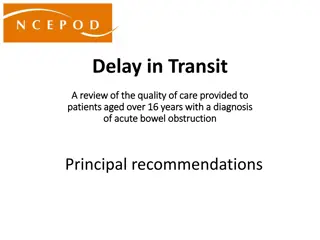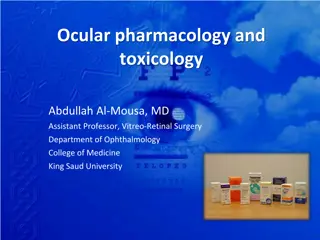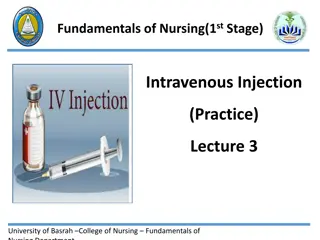Biospecimen Collection, Storage, and Shipment Overview at USC Central Laboratory
This overview covers the types of biospecimens collected, specimen collection schedule, supplies, protocols, and shipping instructions at the USC Central Laboratory. It includes details on whole blood collection for different assays, storage procedures, and shipment to USC Labs and Charles River Lab
0 views • 21 slides
Efficacy and Safety of Ferric Carboxymaltose for Heart Failure with Iron Deficiency
Iron deficiency is prevalent in heart failure patients with reduced ejection fraction and is linked to poor outcomes. The HEART-FID trial investigates the impact of intravenous ferric carboxymaltose (FCM) on all-cause mortality, heart failure hospitalizations, and exercise capacity in chronic HFrEF
1 views • 17 slides
Evolution in HDL Hypothesis: CSL-112 Infusions in Acute Myocardial Infarction
This study explores the use of CSL-112 infusions in patients with acute myocardial infarction to enhance high-density lipoprotein (HDL) function. By focusing on improving HDL-C function through ApoA-1 infusions, the research aims to enhance outcomes associated with cardiovascular events. The efficac
4 views • 27 slides
Skin Care Clinic in Raumati South
Are you looking for the best Skin Care Clinic in Raumati South? Then visit Glamroom. Their team of experts specializes in laser genesis for skin rejuvenation, laser hair removal, ultraceuticals facials using sonophoresis for vitamin skin infusions, Aspect Dr Peels, hair and makeup for weddings and e
6 views • 6 slides
Understanding Fluid Therapy in Veterinary Medicine
In the nineteenth century, fluid therapy was limited to severely ill patients, but now both veterinary and human medicine utilize intravenous fluid therapy extensively. Dehydration can have serious consequences, and isotonic replacement fluids are essential based on estimated dehydration, maintenanc
1 views • 20 slides
Understanding Blood Transfusion: Components, Preparation, and Safety Measures
Blood transfusion is a crucial medical procedure involving the transfusion of different blood components to patients in need. This practice has evolved to include various components such as packed red blood cells, plasma, platelets, and more. The preparation of these components involves specific tec
1 views • 45 slides
Introducing Sirush Cancer Treatment Protocol: A Breakthrough in Cancer Therapy
This research introduces the Sorush Cancer Treatment Protocol (SCTP), a novel approach developed by Dr. Somayeh Zaminpira and Dr. Sorush Niknamian based on successful cancer treatment methodologies. The protocol combines a Specific Ketogenic Diet (SKD), intravenous ozone therapy, and various supplem
0 views • 6 slides
Intravenous Anaesthetics and Barbiturates: Usage, Advantages, and Disadvantages
Intravenous anaesthetics, including barbiturates and non-barbiturates, offer advantages such as easy induction and smooth recovery but come with drawbacks like lack of control over anaesthesia level and contraindications in certain conditions. Barbiturates, derived from melonyl urea, are classified
1 views • 24 slides
Enhancing Clinical Excellence: SCENS Nursing Simulation Programs
Explore SCENS Nursing Services focusing on clinical excellence through simulations. Learn about infusion practices, transfusion reactions, communication strategies, and facility-specific protocols. Delve into practical learning objectives, safety guidelines, and important considerations in nursing c
0 views • 14 slides
Clinical Excellence in Nursing: SCENS Simulation Program
This comprehensive SCENS simulation program focuses on enhancing nursing skills in initiating intravenous accesses, administering antibiotic infusions, and effective patient communication. Covering essential topics like safe medication practices, adverse event reporting, and patient safety improveme
1 views • 13 slides
Understanding Injections and Infusions in Healthcare
Determining the hierarchy of injections and infusions is crucial in medical coding and billing. Infusions are prioritized over pushes, which are prioritized over injections. This hierarchy should be followed for accurate reporting and coding. IV Infusion Therapy involves administering fluids or medi
0 views • 57 slides
Understanding Intravenous Infusions and Injections in Healthcare
Intravenous infusions and injections play crucial roles in healthcare by delivering drugs and fluids directly into the body. Injections can be administered in various ways, including intravenous, intramuscular, and subcutaneous routes. Intravenous infusions provide fluids, electrolytes, and medicati
4 views • 20 slides
Role of Radiology Resource Nurses in Healthcare
In November 2018, the need for Nursing Coverage in the Radiology Department led to the identification of the Role of Radiology Resource Nurses (RRN). These critical care-trained Registered Nurses act as clinical liaisons between patient care areas and the Radiology Department, ensuring continuity of
0 views • 21 slides
Understanding Parenteral Fluid Therapy and IV Solutions
This informative content explores the essentials of parental fluids therapy, including the indications, types of IV solutions (isotonic, hypotonic, hypertonic), and categories of intravenous solutions based on their purpose. It covers the significance of IV solutions containing dextrose or electroly
0 views • 37 slides
Enhancing Emergent Care in Athletic Training: Intravenous Therapy Overview
This presentation discusses the role of intravenous (IV) therapy in athletic training, focusing on sport-related causes for IV fluid replacement, patient signs and symptoms necessitating IV therapy, proper application of angiocatheter insertion, and regulatory considerations. It highlights the impor
0 views • 32 slides
Clinical Practice Guidelines for Rhabdomyolysis: Management and Recommendations
Rhabdomyolysis is a condition with a significant impact on kidney function, requiring prompt clinical management to prevent morbidity and mortality. This article discusses the prevalence, patient population criteria, admission criteria, treatment options, and potential complications associated with
1 views • 13 slides
Understanding Digoxin Pharmacology and Clinical Use
Digoxin, a cardiac glycoside, is utilized in managing congestive heart failure and atrial fibrillation due to its inotropic and chronotropic effects on the heart. It functions by inhibiting Na,K-ATPase, leading to increased intracellular calcium concentrations and augmented myocardial contractility.
5 views • 23 slides
Community Intravenous Therapy Team in Gloucestershire: Providing Outpatient Antibiotic Therapy
The Community Intravenous Therapy (IVT) Team in Gloucestershire offers outpatient antibiotic therapy services, accepting referrals from GPs, consultants, doctors, and specialist nurses. Changes to the service, details on antibiotic choices, frequently treated infective conditions, and contact inform
0 views • 9 slides
Understanding Intravenous Infusions: Types and Administration
Intravenous infusions are sterile pharmaceutical solutions or suspensions administered via different routes into the body for various medical needs. These infusions, such as D51.2NS, play a crucial role in providing essential nutrients and medications to patients. Intravenous administration sets and
0 views • 23 slides
Severe Malaria Treatment Guidelines by WHO
Severe malaria requires prompt diagnosis and treatment to prevent death and complications. The main focus is on achieving therapeutic concentrations of effective antimalarials quickly. Management involves clinical assessment, specific antimalarial treatment, addressing complications, and supportive
0 views • 18 slides
Central Venous Catheters: Uses, Placement, and Indications
A central venous catheter (CVC) is a crucial medical device placed into a large vein for various purposes like administering medication, fluids, and obtaining blood tests. The catheter can be tunneled or non-tunneled, and specific sites are preferred for each type. Indications for CVC usage include
1 views • 19 slides
Animal Use Protocols: Finding the Right Balance
Exploring the analogy between the story of the three bears and animal use protocols, this content delves into the importance of providing just the right amount of information in research protocols. Through examples of intravenous injections in mice, the text emphasizes the necessity of striking the
0 views • 8 slides
Understanding General Anesthetics and Anesthesia
General anesthesia induces a reversible state of CNS depression, providing sedation, amnesia, muscle relaxation, reflex suppression, and analgesia. Preanesthetic medications prepare patients for the process, including antiemetics and anticholinergics. Anesthetics are delivered via inhalation or intr
0 views • 42 slides
Understanding Equipment and Techniques in Intravenous Preparation
Explore the role and function of equipment like syringes, needles, IV sets, catheters, etc., in IV preparation. Learn about IV solution characteristics, aseptic technique in pharmacy, handling hazardous drugs, and quality assurance programs in hospitals. Discover the importance of aseptic technique
0 views • 69 slides
Understanding Differences in IV Antibiotic Administration in Emergency Departments
Characterizing the shift from intravenous piggyback to intravenous push antibiotic administration in the emergency department, this study highlights the impact of antibiotic timing on patient outcomes, emphasizing the importance of quick and appropriate empiric antibiotic administration. Insights fr
0 views • 21 slides
Understanding Magnesium Metabolism and Hypomagnesaemia
Magnesium, mainly an intracellular ion, plays a crucial role in enzyme function and cell membrane stability. Its renal handling involves filtration and reabsorption, with hypomagnesaemia often linked to hypocalcaemia. Causes include inadequate intake, excessive losses from GI and urinary sources, an
0 views • 17 slides
Review of Care for Patients with Acute Bowel Obstruction: Recommendations and Key Findings
This review assesses the quality of care provided to patients aged over 16 years with acute bowel obstruction. Significant delays were identified in the care pathway, from imaging requests to availability of operating theatres. Recommendations include prompt CT scans with intravenous contrast for de
0 views • 32 slides
Blow-Fill-Seal Technology Market Forecasted to Reach USD 452.6 Million by 2026
The global blow-fill-seal technology market is projected to hit USD 452.6 million by 2026. This technology is mainly used in pharmaceutical packaging for eye drops, inhalation products, infusions, and parental preparations. Key players in the market include Recipharm, Rommelag, Catalent, and more. T
0 views • 4 slides
Understanding Intravenous Fluid Resuscitation and Blood Transfusion in Clinical Practice
Intravenous fluid resuscitation and blood transfusion are crucial components of patient care, involving the direct administration of fluids and electrolytes to maintain proper fluid balance. When calculating the volume of fluid to be replaced, various factors must be considered, including maintenanc
0 views • 15 slides
Understanding Ocular Pharmacology: General Principles and Drug Delivery
The study of ocular pharmacology involves understanding general pharmacological principles, pharmacodynamics, and pharmacokinetics. Drugs can be delivered to ocular tissue locally via eye drops, ointments, injections, or systemically through oral or intravenous routes. Factors such as drug concentra
0 views • 58 slides
Understanding Postoperative Pain Management: Lessons in Practice
Exploring the impact of perioperative intravenous ketamine on acute postoperative pain in adults, a review analyzed data from 130 studies with 8341 participants. The study focused on pain intensity, opioid consumption, and surgery type, presenting results using graphical approaches. Key findings hig
0 views • 18 slides
Intravenous Injection: Fundamentals and Practices in Nursing
Intravenous injection is a crucial method for administering medications directly into the bloodstream. The process involves introducing medications quickly and efficiently through a vein using an IV access. While IV bolus allows for rapid delivery, it requires careful monitoring to avoid adverse rea
0 views • 30 slides





